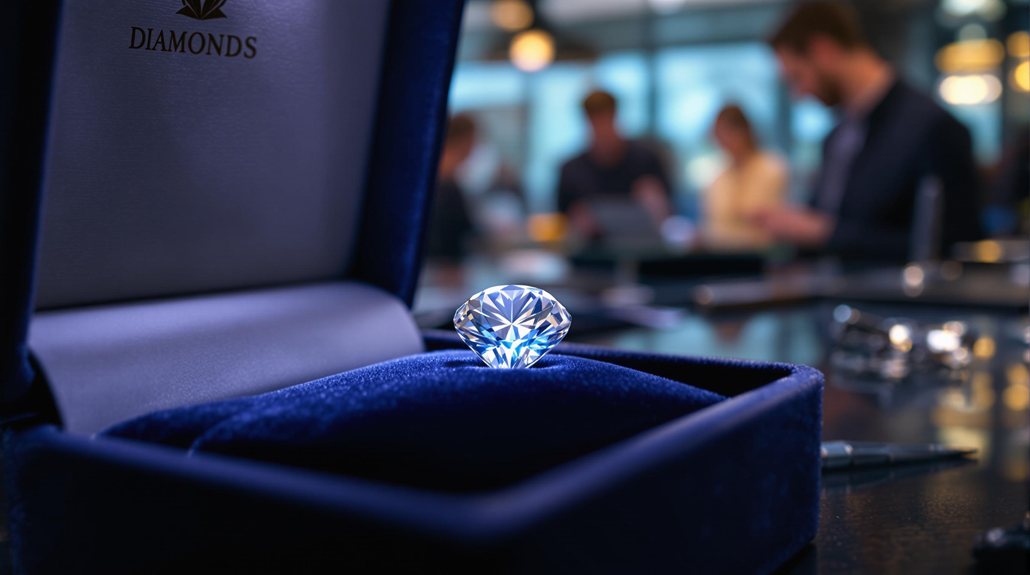Lab-Grown Diamonds Shine as Young Buyers Shun Traditional Stones
Lab-grown diamonds are becoming a favourite among young consumers who increasingly value sustainability and ethics over tradition. These diamonds are created in laboratories, sharing the same characteristics as natural stones while being more affordable, often priced 30-70% lower. Unlike natural diamonds, lab-grown ones are conflict-free and environmentally friendly, appealing to younger generations who prioritise ethical sourcing. The market reflects this shift, with significant growth in production and demand, especially among Millennials and Gen Z. Major industry players are responding by expanding their lab-grown offerings, setting the stage for exciting developments in the world of diamonds. Uncover what lies ahead.
Article Contents
Main Highlights
- Young consumers prefer lab-grown diamonds for their ethical and sustainable sourcing, aligning with their values on environmental responsibility.
- Lab-grown diamonds are cost-effective, offering significant savings compared to traditional stones, appealing to budget-conscious young buyers.
- The absence of conflict and human rights abuses in lab-grown diamond production attracts ethically minded younger generations.
- Controlled production of lab-grown diamonds results in higher clarity grades, providing quality assurance to discerning young consumers.
- Rising demand for lab-grown diamonds reflects a shift in consumer preferences, with major brands expanding offerings to cater to younger demographics.
Understanding Laboratory-Grown Diamonds
The innovation of lab-grown diamonds represents a significant advancement in the gemmological field, offering a sustainable and ethically responsible alternative to mined diamonds. These diamonds, formed in laboratories through advanced technological processes, mirror the natural environment of high pressure and temperature.
Lab-grown characteristics include the same chemical and physical properties as natural diamonds, making them indistinguishable to the naked eye. They can be produced in an array of colours such as white, yellow, blue, pink, and green, with clarity grades often surpassing those of their natural counterparts due to controlled conditions. Moreover, lab-grown diamonds are typically about 30% less expensive than natural diamonds, making them an attractive choice for budget-conscious buyers.
The certification process for lab-grown diamonds guarantees authenticity and quality, with each stone receiving a unique report number and the initials of the certifying lab or agency, visible under magnification. This process mirrors the grading system used for natural diamonds, focusing on the Four Cs: colour, cut, clarity, and carat. Lab-grown diamonds typically reach up to 20 carats and develop in about 6 to 10 weeks.
With minimal environmental impact, these gems appeal to a growing market of consumers seeking freedom from the ethical and ecological concerns associated with traditional diamond mining. The carbon footprint of lab-grown diamonds is significantly lower, as they consume less water and energy while emitting far less CO2 compared to mined diamonds.
Cost and Affordability Factors
Despite sharing the same brilliance and allure, lab-grown diamonds offer a more cost-effective alternative to their natural counterparts. With prices ranging from under £1,000 to nearly £10,000 per carat, depending on factors like size and clarity, these gems provide a budget-friendly option for consumers. Typically, lab-grown diamonds are 50-70% less expensive than mined stones of similar quality, making them an appealing choice for those seeking value without compromising on beauty.
This affordability disrupts traditional diamond trade economics, enabling buyers to afford larger stones that were once out of reach. Lab-grown diamonds also have a smaller environmental impact compared to natural diamonds, making them a more sustainable option. Consumer preferences are shifting towards lab-grown diamonds partly due to these price fluctuations.
As the prices of natural diamonds have seen slight increases, the cost of lab-grown alternatives has decreased dramatically. This trend is influenced by factors such as the manufacturing processes—High Pressure-High Temperature (HPHT) or Chemical Vapour Deposition (CVD)—and the diamond’s shape, with round brilliants commanding higher prices.
Major players in the diamond industry, like De Beers, have responded by introducing lab-grown lines to meet the rising demand. While resale value remains lower than that of natural diamonds, the immediate cost savings and growing popularity among younger buyers highlight a significant shift in consumer preferences. In April 2024, natural diamond prices saw a 12.34% decrease, with the average cost of a one-carat round diamond falling to £4,875, further emphasising the economic appeal of lab-grown options.
Ethical and Environmental Benefits
Lab-grown diamonds present numerous ethical and environmental benefits, distinguishing them as a responsible choice for conscientious consumers. These stones are certified conflict-free, ensuring ethical sourcing by not contributing to human rights abuses prevalent in some mining operations. The production of lab-grown diamonds circumvents the exploitation and displacement of communities, guaranteeing fair and safe working conditions through regulated environments and advanced safety protocols.
This transparency assures buyers against unethical practices and supports the reduction of the conflict diamond trade. Notably, the diamond industry has room for improvement, as it lacks conclusive evidence on overall sustainability, thus prompting the need for more research and transparency.
In terms of environmental impact, lab-grown diamonds require significantly less land, water, and energy than their mined counterparts. The absence of large-scale land excavation preserves biodiversity and prevents habitat destruction. The controlled production processes generate fewer carbon emissions and avoid the ecological footprints linked to traditional mining, such as soil erosion and water pollution. Additionally, the sustainability of lab-grown diamonds is enhanced by their consistent quality due to controlled production conditions, which also supports innovation in the jewellery industry.
Moreover, the use of renewable energy sources further amplifies their eco-friendly credentials. Lab-grown diamonds also safeguard local communities by not displacing them or damaging wildlife habitats. By fostering technological innovation, the industry offers new economic opportunities without the socio-economic disruptions of mining. In addition, lab-grown diamonds provide a more ethical option for consumers who are concerned about the impact of traditional diamond mining on local communities and the environment. Furthermore, the rise of lab-grown diamonds has created new opportunities for female entrepreneurs in diamond districts, allowing them to establish their own businesses within the industry and contribute to its growth and innovation. This shift towards sustainable and ethical practices in the diamond industry not only benefits the environment, but also supports the economic and social development of local communities.
Ultimately, lab-grown diamonds exemplify a sustainable path forward, aligning ethical sourcing with reduced environmental impact.
Shifting Market Trends
In the dynamic landscape of the diamond industry, shifting market trends underscore the growing prominence of lab-grown diamonds as a transformative force. The market dynamics are evolving rapidly, with the global lab-grown diamonds market size valued at USD 18.91 billion in 2023. Projections suggest it will soar to USD 34.06 billion by 2030, driven by a compound annual growth rate (CAGR) of 8.8% from 2024 to 2030. The remarkable growth of lab-grown diamonds highlights their alignment with consumer values of sustainability and ethical sourcing, as they are created in controlled environments that ensure quality and ethics.
This remarkable growth is propelled by increasing consumer preferences for ethical and sustainable choices, particularly among Millennials and Gen Z. Lab-grown diamonds, which cost up to 50% less than their natural counterparts, cater to budget-conscious buyers seeking affordable luxury. Technological advancements, such as those by Diamond Quanta, are enhancing production efficiency and reducing costs, further fuelling demand. The market expansion reflects a wide array of players, meeting the needs of consumers across diverse segments, from engagement rings to fashion jewellery and industrial applications. Furthermore, China accounted for 40-50% of global production capacity in 2023, solidifying its position as the largest producer of lab-grown diamonds.
Moreover, the opening of new production facilities, like Diamond Foundry’s factory in Spain, is set to produce over 2 million carats annually, solidifying the market’s growth trajectory. These shifting trends highlight a significant transformation, challenging traditional diamond markets to adapt.
Comparing Diamond Types
As the diamond industry navigates evolving market trends, understanding the distinctions between lab-grown and natural diamonds becomes increasingly important.
Lab-grown diamonds share the same chemical composition and physical properties as their natural counterparts, ensuring diamond durability and brilliance. However, their formation process differs greatly, with lab-grown diamonds created in weeks using advanced technology, while natural diamonds form over billions of years. Lab diamonds are considered more sustainable than mined diamonds. Lab-created diamonds offer long-term sustainability benefits, addressing environmental and humanitarian concerns associated with natural diamond mining.
Despite their similar appearance, gem authenticity varies. Lab-grown diamonds lack nitrogen, a trace element found in natural diamonds, and may feature unique inclusions like metallic spots. This distinction is vital for those valuing diamond rarity and authenticity, as natural diamonds carry a historical allure that lab-grown stones cannot replicate.
Price is another key factor; lab-grown diamonds are 60-85% less expensive, appealing to cost-conscious buyers. However, they have limited resale value, a consideration for those seeking long-term investment.
Ethical and environmental concerns also favour lab-grown diamonds, as they avoid the environmental impact of traditional mining.
Ultimately, the choice between lab-grown and natural diamonds hinges on individual preferences for affordability, sentimentality, and ethical considerations, offering freedom for consumers to align their values with their purchases.
Frequently Asked Questions
How Long Does It Take to Create a Lab-Grown Diamond?
The creation process of lab-grown diamonds varies by growth methods. High Pressure High Temperature (HPHT) can produce 1-carat diamonds in 2-3 days, whereas Chemical Vapour Deposition (CVD) requires 7-8 days, depending on quality specifications.
Can Lab-Grown Diamonds Be Used for Industrial Purposes?
Yes, lab-grown diamonds are ideal for industrial applications due to their uniform properties and cost-effective manufacturing processes. They offer exceptional hardness, thermal conductivity, and transparency, making them suitable for electronics, optical devices, and aerospace industries.
Are Lab-Grown Diamonds Insured Like Natural Diamonds?
Lab-grown diamonds and insurance policies are like two sides of a coin. Although insurable, their value comparison to natural diamonds results in distinct valuation methods, often yielding lower premiums and payouts, reflecting their evolving market dynamics.
What Are the Resale Values of Lab-Grown Diamonds?
Lab-grown diamonds typically have lower resale values due to market dynamics and consumer perception. In the resale market, factors such as production cost, technological advances, and fluctuating demand impact their value, challenging their appeal as investment assets.
Do Lab-Grown Diamonds Require Special Maintenance?
Lab-grown diamonds do not require special maintenance beyond regular care. Maintenance tips include using gentle cleaning methods such as mild soap solutions and avoiding harsh chemicals. Regular professional inspections also guarantee lasting brilliance and prevent potential damage.
Our Closing Thoughts
Lab-grown diamonds have experienced a surge in popularity, particularly among younger consumers, due to their affordability and ethical advantages. A notable statistic highlights this trend: in 2022, sales of lab-grown diamonds increased by 40%, reflecting a significant shift in consumer preferences. These diamonds offer a sustainable alternative to traditional stones, reducing environmental impact and ethical concerns associated with mining. As the market continues to evolve, lab-grown diamonds are poised to become a dominant choice in the jewellery industry.




